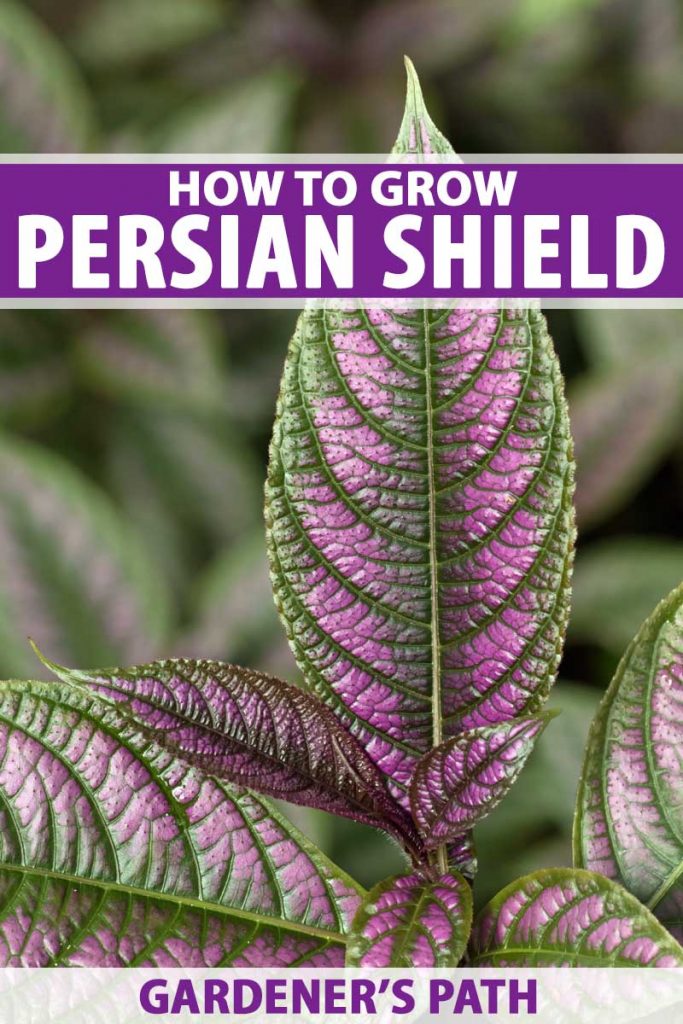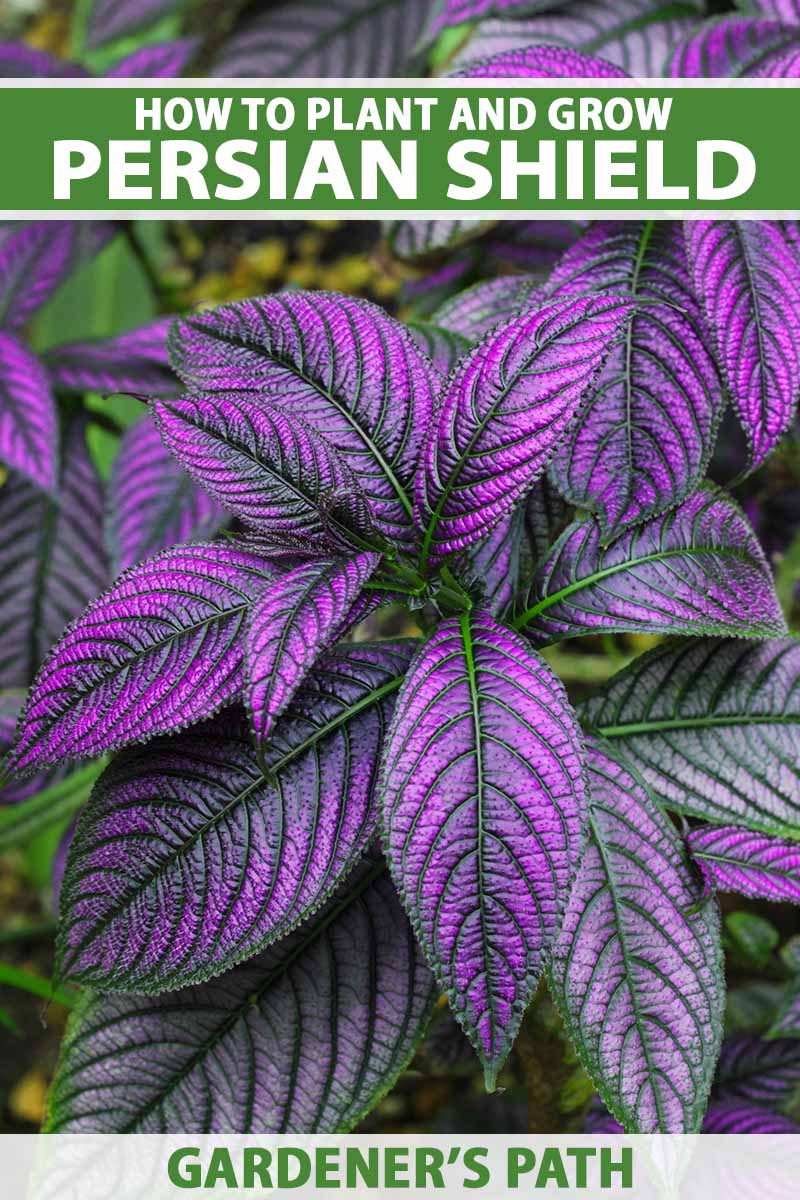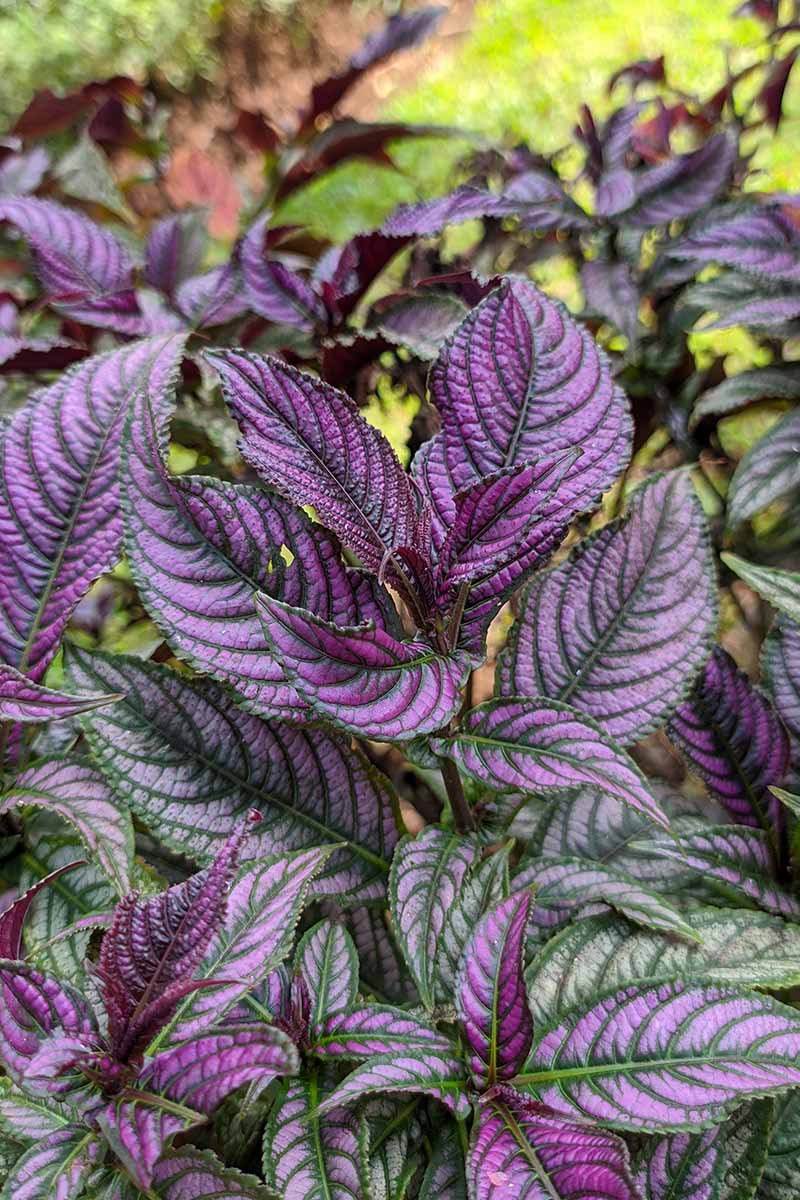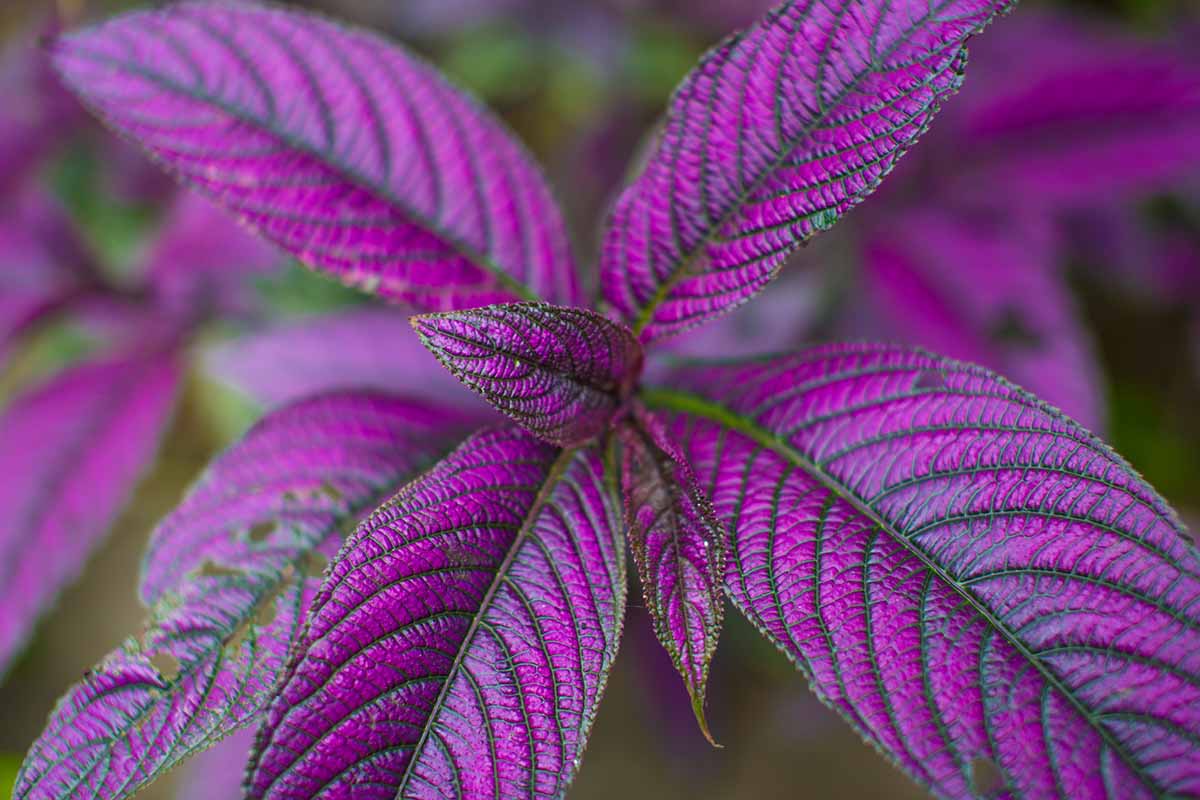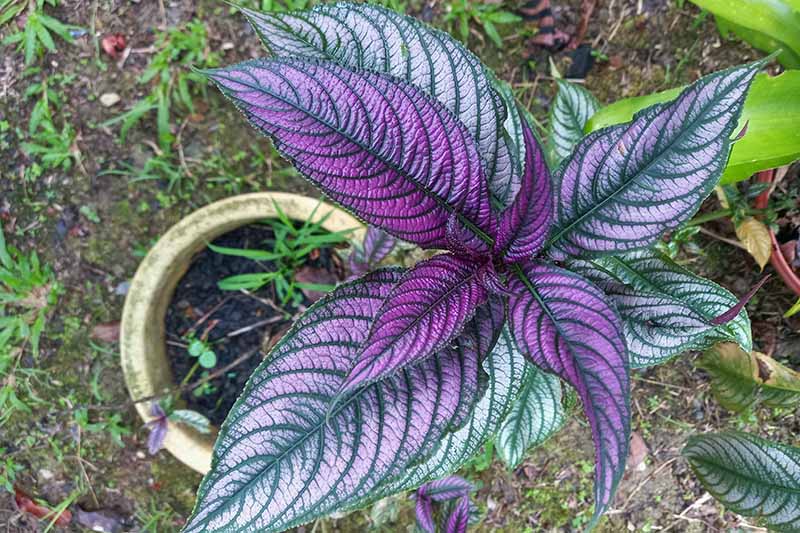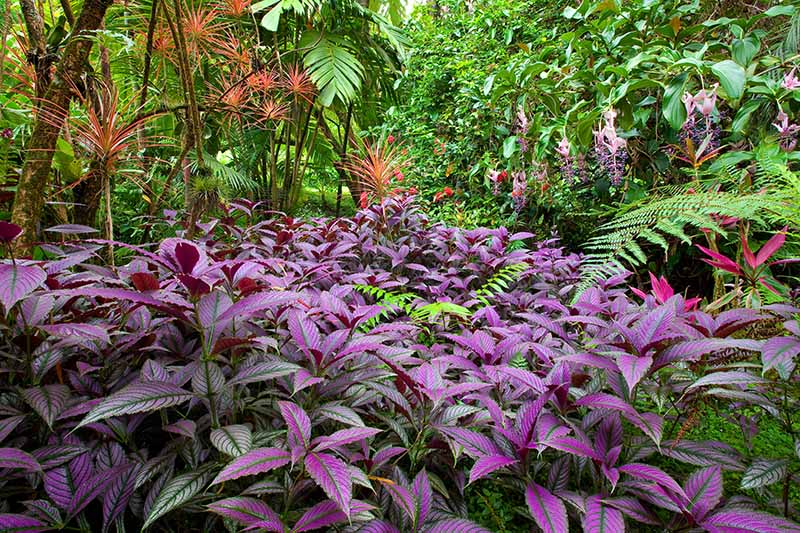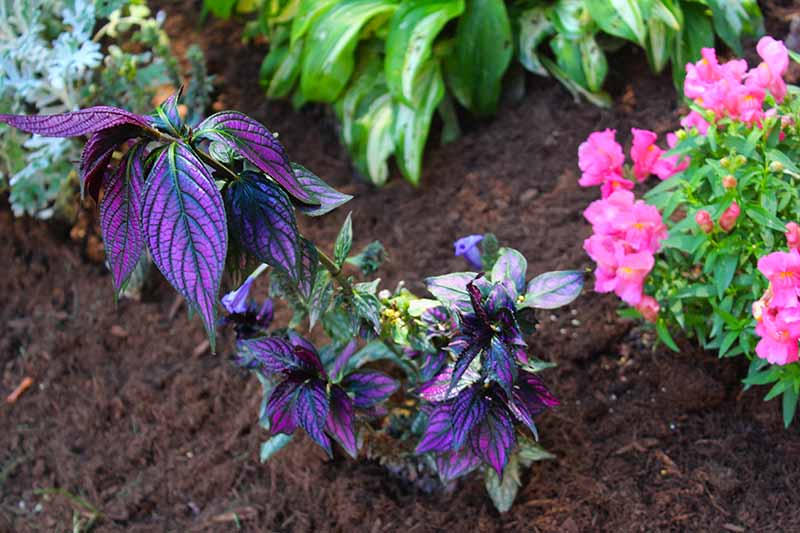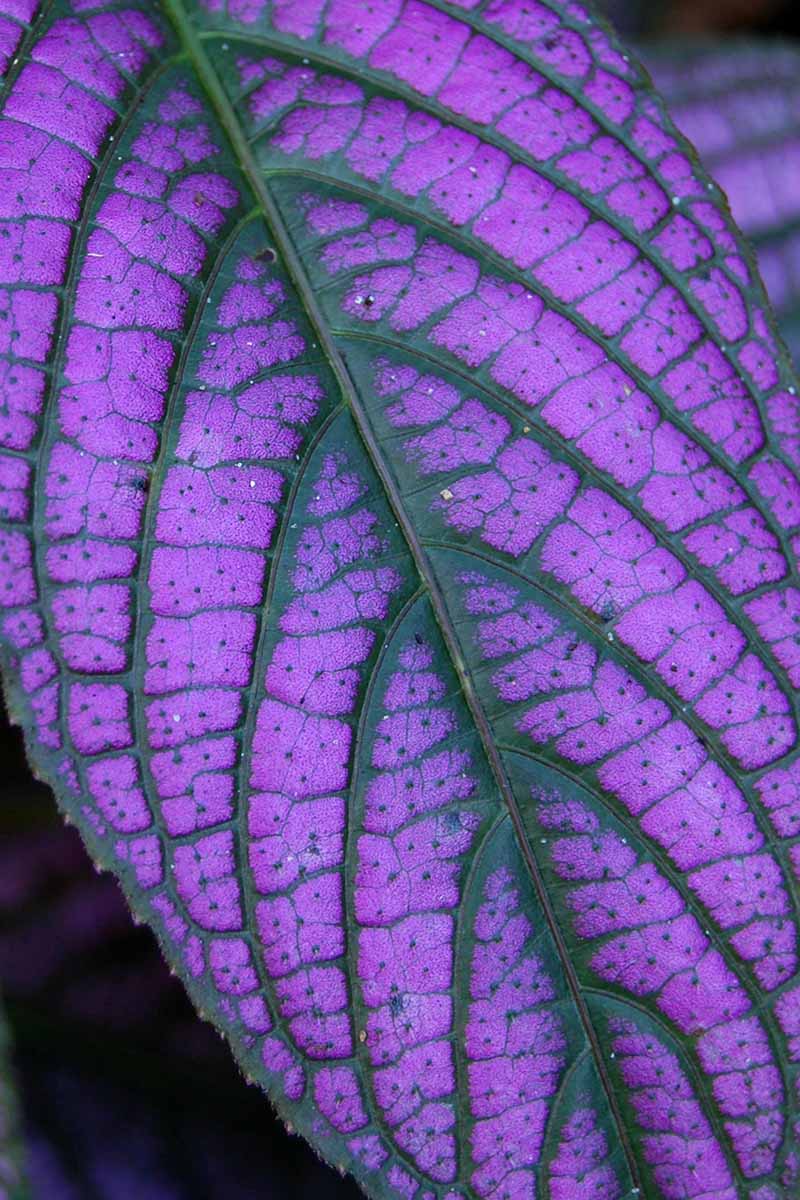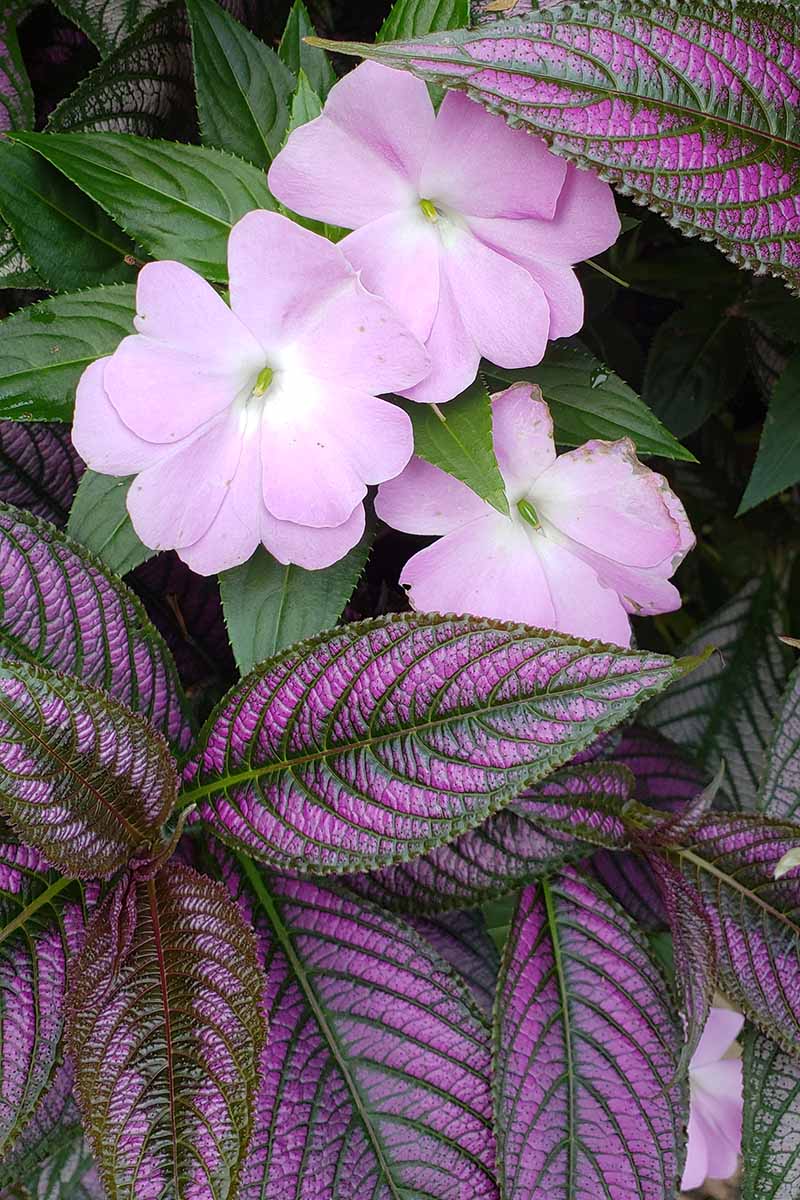It is a member of the Acanthaceae family, which consists mostly of flowering tropical flora. With its unique iridescent purple leaves, S. dyerianus had no difficulty attracting the attention of US gardeners, and is now grown here as an annual, perennial, and houseplant. We link to vendors to help you find relevant products. If you buy from one of our links, we may earn a commission. In this article, you will learn all you need to know to cultivate this delightful tropical foliage outdoors in USDA Hardiness Zones 10 to 11. It may also be grown as an indoor houseplant in all locales. Here’s what we’ll cover: Let’s start with a little background.
Cultivation and History
Tropical Persian shield, aka royal purple plant, thrives on heat and humidity, yielding its most brilliant color in bright, indirect sunlight and partially shaded locations. It prefers temperatures above 60°F. The characteristic broadleaf foliage positively shimmers. Neon shades of purple veined with green seem to be overlaid with a silver gloss. The growth habit is upright with leaves that are lance-shaped and measure six to eight inches long. Stems are soft and may exceed three feet in height. Over time, they may become woody. Small, tubular, cone-shaped blue flowers, reminiscent of Virginia bluebells may bloom in season, but these are a rarity. The reason is not entirely understood, but is believed to be an example of “masting” behavior, in which blooming is sporadic, but profuse when it occurs. This botanical phenomenon makes it impossible for wildlife to depend upon the seeds for food, as they are not always available. In cooler regions, Persian shield grows as a summer annual, often failing to exhibit its most vibrant color, and dying off with the first frost. Despite the frequent lack of blooms, the Latin Strobilanthes is an apt description because it means coneflower. The species name, dyerianus, recognizes the botanist who oversaw the Royal Botanic Gardens at Kew at the turn of the last century, Sir William Turner Thiselton-Dyer. S. dyerianus was undoubtedly introduced to Europe by flora hunters of the era, and became part of the famous Kew collection. From Europe, Persian shield made its way into American Victorian gardens and households at a time when tropical foliage was enjoying its first North American heyday.
Propagation
To grow S. dyerianus, you’ll need to take a soft stem tip cutting from a friend’s plant, or purchase a potted one from a nursery. Seeds are not readily available. Here’s how to get started.
From a Soft Stem Tip Cutting
To start with a cutting from existing foliage, cut a length of stem, measuring from the growing tip down about four or five inches. If blooming has occurred, wait until the last flower drops and a flush of new growth appears. Be sure to cut about one-quarter of an inch above a leaf node, the place where leaves originate. Remove the bottom pair or pairs of leaves to reveal about three inches of bare, leafless stem. Place the bare stem in a narrow clear container containing two inches of water. Change the water daily. Once roots grow to at least an inch long, transplant the cutting to a well-draining vessel filled three-quarters of the way with potting soil, or plant it out in the garden. Be sure to take mature dimensions into account when growing in the garden or outdoor containers. Plants need between one and three feet to spread out, and a soil depth of about 12 inches to support healthy root development. Bury about one inch of the rooted stem in the soil, so the crown, where the roots and stem meet, is buried. Tamp the soil down securely. Maintain even moisture by watering when the top three to four inches of the soil feel dry. Avoid letting pots dry out completely, but don’t oversaturate the potting medium.
Nursery Pot Transplanting
For outdoor container gardening, choose a well-draining vessel with a depth of at least 12 inches. Fill it three-quarters full with organically-rich potting soil. For transplant to the garden, work the ground soil to a depth of eight to 12 inches. Amend with compost as needed to provide organically-rich earth that drains well. Unpot the plant and carefully detangle the roots if necessary. Place the contents of the pot into the ground or container so that it sits at the same depth it was at in the pot. Tamp the soil firmly over the roots and around the stems, and water well. Maintain even moisture by watering when the top three to four inches of soil feel dry.
How to Grow
In Zones 10 to 11, you can cultivate your plant year-round in the ground or in outdoor containers, for evergreen foliage. If you are in Zone 8 or 9, you may find that the foliage withers and dies at season’s end, but the roots remain alive and sprouts appear again each spring. This is especially likely when you apply a three-inch layer of mulch over the root zone, as we will discuss in the pruning and maintenance section below. For those of us in cold zones, like me, this species grows as an annual that dies back in its entirety, roots and all, and doesn’t return. To grow S. dyerianus in a container, select an indoor location with bright, indirect sunlight, or an outdoor one with dappled sun to part shade. If the light is too bright, the leaves will appear pale and may even scorch. For container gardening, use a good quality, organically-rich potting soil and a container with adequate drainage holes and a depth of at least 12 inches. Keep the soil moderately moist by watering when the top third of the soil feels dry to the touch. A moisture meter can help you to gauge when water is needed. Indoor pots may need water more than once a week, so check daily. For garden growing, work the ground to a depth of eight to 12 inches. Amend the soil as needed with organically-rich compost or aged manure to achieve a loamy consistency that drains well and has a pH in the range of 5.5 to 7.5. As described above, secure a rooted cutting or nursery plant firmly in the soil. Bury the cutting about one inch deep, or set nursery plants at the same depth they were growing in their containers. Water weekly in the absence of rain, using a moisture meter as your guide. Fertilize at planting time and midway through the growing season, using a liquid plant food diluted to 50 percent.
Growing Tips
The secrets to successful Persian shield cultivation include:
Starting with rooted cuttings or nursery stock.A location or container with organically-rich soil that drains well and has fairly neutral soil acidity.Maintaining even moisture, neither overwatering nor allowing the soil to completely dry out.Fertilizing regularly with half-strength liquid plant food to support foliar growth.
Pruning and Maintenance
S.dyerianus is a low-maintenance species. If it gets leggy, pinch or snip the stems back just above a leaf node, to promote bushy, compact growth. In addition, if a plant gets too hot and/or dry, pinch off leaves that have scorched patches or brown tips, to redirect energy toward healthy growth. Similarly, if a stem or leaf breaks, snip it off, as open wounds increase vulnerability to pests and pathogens. If your plants experience a widespread pest infestation, or have old woody stems, you may want to take some unaffected soft stem tip cuttings to propagate new ones before disposing of the parent plant. And finally, to try to winter over in Zone 8 or 9 for perennial growth, first remember to take a few cuttings during the summer to root in water, in case of failure. When the foliage dies with the first frost, remove the wilted debris and apply a three-inch layer of mulch over the root zone. If you are growing in a container, you can wrap the entire pot in burlap and place it in a sheltered location until spring. Alternatively, you can dig up entire plants before the first frost to winter over as houseplants. Read more about growing Persian shield indoors in our guide. (coming soon!)
Where to Buy
Persian shield is available in nurseries and online for both indoor and outdoor cultivation. With diligent care of a quality starter plant, you can achieve mature dimensions of up to three feet tall and wide. Container growing is more likely to result in smaller stature than in-ground cultivation. Persian Shield As it matures, you can take soft stem cuttings to multiply your investment for keeping or giving as gifts to your gardening friends.
Managing Pests and Disease
Persian shield is not particularly prone to pests or disease. However, sometimes there are issues. Common culprits include aphids, fungus gnats, and spider mites. Aphids are sap-suckers that feed on foliage. If you catch them early, a firm spray with the hose may be all you need to dislodge and destroy them. More extensive infestations may be treatable with an application of organic insecticidal neem oil. Fungus gnats are soilborne flying insects that seem to appear as if by magic in overly wet soil, particularly in potted plants. A few sticky traps and a reduction in watering will usually take care of the problem. Spider mites are sapsuckers that feed on plants that are too dry. A rinse with the hose, application of a pyrethrin-containing insecticide, and regular watering usually do the trick to remedy an infestation. It’s important to maintain plant health and avoid pests, as in addition to being menaces themselves, many carry diseases that can be transmitted via their mouthparts. You are not likely to encounter any common plant diseases when cultivating S. dyerianus.
Best Uses
With its vivid silvery-purple hues, Persian shield makes a bold perennial statement in warm-region gardens. It also pairs well with species that have similar requirements for dappled sun to partial shade, and organically-rich, well-draining loam. Try it in mixed beds that contain vibrant pink and green caladiums and impatiens. Place it in containers with trailing lime green sweet potato vine, pink snapdragon, and silvery green dusty miller. And plant it on the sun-dappled fringes of gardens overflowing with ferns and snake plants, where their green textures make the purple foliage stand out dramatically. Indoors, it’s quite a conversation-piece where the temperature is at least 60°F, the sun is indirect, and the moisture is ample but not excessive.
Quick Reference Growing Guide
Versatile and Vibrant
Persian shield has exceptional foliage that may be enjoyed in numerous ways. Let it reach full height, so its leggy clumps can sprawl recklessly across a garden bed, providing a gleaming, informal backdrop for foreground specimens. Or, pinch it back, sacrificing height, but achieving a bushy, compact profile suited to formal borders and well-behaved mixed groupings. And finally, if you’re in a cool climate zone, bring plants indoors for the winter, or keep them inside year-round as easy-to-tend houseplants. Pinch them back as desired to maintain shape. If you live in the southern part of the United States, you may have the pleasure of seeing the blue blossoms of Persian shield in your autumn or winter garden. For additional late-blooming flower ideas, consult our article on fall annuals for the south. Do you grow Persian shield? Are you cultivating it indoors or outdoors, and in containers or in the garden? Share your experiences with this unique tropical species in the comments section below. If you found this article informative and would like to read more about cultivating vibrant foliage plants, we recommend the following:
How to Grow Coleus in Your GardenHow to Grow Colorful CaladiumsHow to Grow Hostas: A Favorite Shade Loving Perennial
